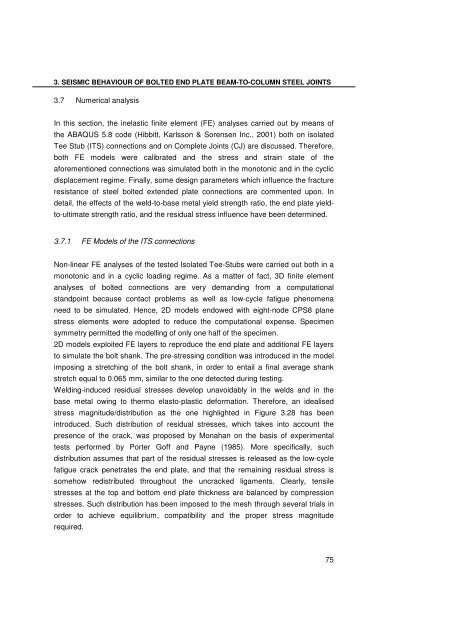Analysis and modelling of the seismic behaviour of high ... - Ingegneria
Analysis and modelling of the seismic behaviour of high ... - Ingegneria
Analysis and modelling of the seismic behaviour of high ... - Ingegneria
You also want an ePaper? Increase the reach of your titles
YUMPU automatically turns print PDFs into web optimized ePapers that Google loves.
3. SEISMIC BEHAVIOUR OF BOLTED END PLATE BEAM-TO-COLUMN STEEL JOINTS<br />
3.7 Numerical analysis<br />
In this section, <strong>the</strong> inelastic finite element (FE) analyses carried out by means <strong>of</strong><br />
<strong>the</strong> ABAQUS 5.8 code (Hibbitt, Karlsson & Sorensen Inc., 2001) both on isolated<br />
Tee Stub (ITS) connections <strong>and</strong> on Complete Joints (CJ) are discussed. Therefore,<br />
both FE models were calibrated <strong>and</strong> <strong>the</strong> stress <strong>and</strong> strain state <strong>of</strong> <strong>the</strong><br />
aforementioned connections was simulated both in <strong>the</strong> monotonic <strong>and</strong> in <strong>the</strong> cyclic<br />
displacement regime. Finally, some design parameters which influence <strong>the</strong> fracture<br />
resistance <strong>of</strong> steel bolted extended plate connections are commented upon. In<br />
detail, <strong>the</strong> effects <strong>of</strong> <strong>the</strong> weld-to-base metal yield strength ratio, <strong>the</strong> end plate yield-<br />
to-ultimate strength ratio, <strong>and</strong> <strong>the</strong> residual stress influence have been determined.<br />
3.7.1 FE Models <strong>of</strong> <strong>the</strong> ITS connections<br />
Non-linear FE analyses <strong>of</strong> <strong>the</strong> tested Isolated Tee-Stubs were carried out both in a<br />
monotonic <strong>and</strong> in a cyclic loading regime. As a matter <strong>of</strong> fact, 3D finite element<br />
analyses <strong>of</strong> bolted connections are very dem<strong>and</strong>ing from a computational<br />
st<strong>and</strong>point because contact problems as well as low-cycle fatigue phenomena<br />
need to be simulated. Hence, 2D models endowed with eight-node CPS8 plane<br />
stress elements were adopted to reduce <strong>the</strong> computational expense. Specimen<br />
symmetry permitted <strong>the</strong> <strong>modelling</strong> <strong>of</strong> only one half <strong>of</strong> <strong>the</strong> specimen.<br />
2D models exploited FE layers to reproduce <strong>the</strong> end plate <strong>and</strong> additional FE layers<br />
to simulate <strong>the</strong> bolt shank. The pre-stressing condition was introduced in <strong>the</strong> model<br />
imposing a stretching <strong>of</strong> <strong>the</strong> bolt shank, in order to entail a final average shank<br />
stretch equal to 0.065 mm, similar to <strong>the</strong> one detected during testing.<br />
Welding-induced residual stresses develop unavoidably in <strong>the</strong> welds <strong>and</strong> in <strong>the</strong><br />
base metal owing to <strong>the</strong>rmo elasto-plastic deformation. Therefore, an idealised<br />
stress magnitude/distribution as <strong>the</strong> one <strong>high</strong>lighted in Figure 3.28 has been<br />
introduced. Such distribution <strong>of</strong> residual stresses, which takes into account <strong>the</strong><br />
presence <strong>of</strong> <strong>the</strong> crack, was proposed by Monahan on <strong>the</strong> basis <strong>of</strong> experimental<br />
tests performed by Porter G<strong>of</strong>f <strong>and</strong> Payne (1985). More specifically, such<br />
distribution assumes that part <strong>of</strong> <strong>the</strong> residual stresses is released as <strong>the</strong> low-cycle<br />
fatigue crack penetrates <strong>the</strong> end plate, <strong>and</strong> that <strong>the</strong> remaining residual stress is<br />
somehow redistributed throughout <strong>the</strong> uncracked ligaments. Clearly, tensile<br />
stresses at <strong>the</strong> top <strong>and</strong> bottom end plate thickness are balanced by compression<br />
stresses. Such distribution has been imposed to <strong>the</strong> mesh through several trials in<br />
order to achieve equilibrium, compatibility <strong>and</strong> <strong>the</strong> proper stress magnitude<br />
required.<br />
75
















